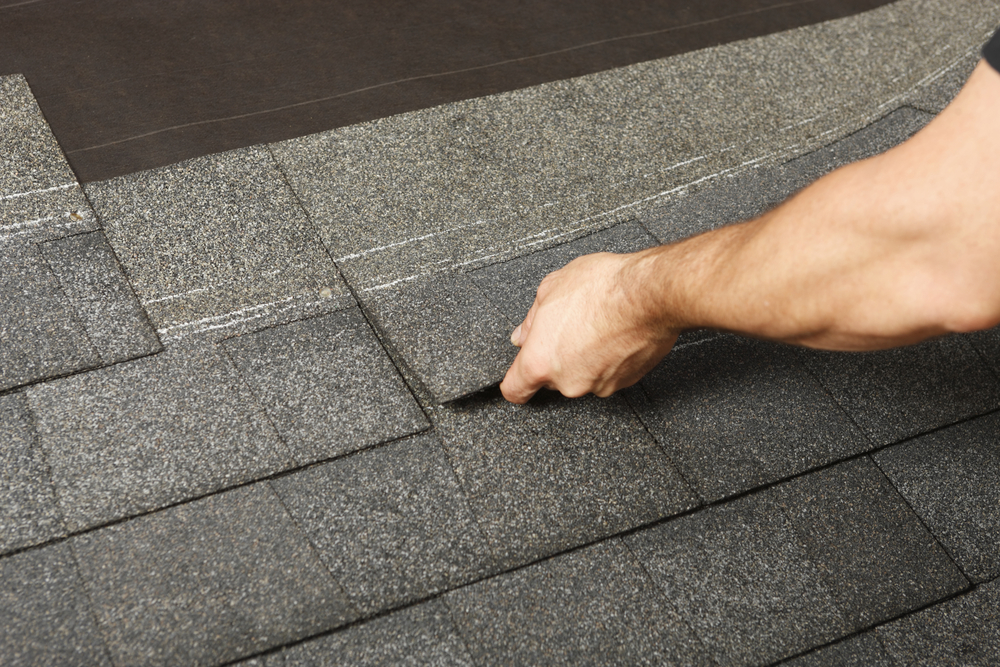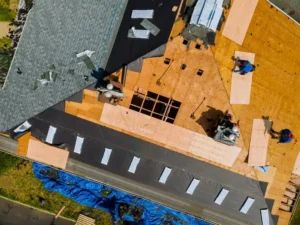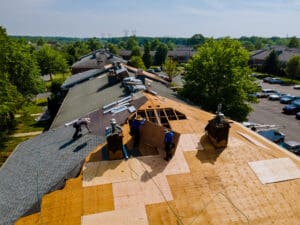Every structure in your home has an expiration date, including the siding, drywall, and roof. Most residential roofing systems last between 20 and 50 years, give or take. How often you need to replace your roof depends on numerous factors, such as your location’s climate, maintenance frequency, and the materials used to construct your roof.
Knowing how often to replace a roof generally depends on you recognizing the signs that the structure is worse for wear. Like many homeowners, you might worry about the expenses that come with a roof replacement. However, an experienced roofer can often help you navigate the insurance claims process and ensure you receive the coverage needed for the task.
Plus, putting off roof replacement can have disastrous effects on the rest of your home. New Rüf’s experts offer guidance on the factors that influence a roof’s lifespan below. Check your rooftop and consider how these details might affect its current condition.
Recognizing the Signs That You Need to Replace Your Roof
Regularly inspect your roof to pinpoint when it’s time to replace it. Perform self-inspections every six months and schedule professional ones annually.
Not only do these habits keep you in the loop about the structure’s durability, but they also alert you to repair and maintenance needs. Thus, you can significantly prolong your roof’s lifespan. Some tell-tale signs that you should replace the roof include:
-
- Damaged materials: Asphalt shingles might curl or lose their granules. Metal panels develop rust, while other materials crack or fracture.
-
- Missing or loose materials: Shingled roofs might lose materials after wind storms. You might find evidence of storm damage strewn around your yard.
-
- Organic growth: Moss, algae, or mold might grow in shady, moist areas. You’ll notice green, blue, or gray patches that don’t match the color of your roof.
-
- Noticeable sagging or warping: When you step outside and observe the roof’s peaks, slopes, and angles, you may discover that something looks off. Once-straight edges seem to sag or bow near the center.
-
- Roof rot: If you enter your attic, you may discover sunlight spilling through cracks and punctures in the sunroof. Water-stained soft spots develop where water damage occurs.
-
- Humid attic: Moist, thick air throughout your attic indicates a leak or ventilation issues.
The Impact of Roof Material on Lifespan
Your current roofing material has a significant impact on how long your roof will last and when you will need to replace it. The material choice affects the roofing system’s durability and energy efficiency. Stronger materials, like metal panels, will withstand more abuse than asphalt shingles.
Which material covers your rooftop? Find its life expectancy below.
-
- Metal, one of the toughest materials, can last up to 75 years in most homes.
-
- Many American residential properties install asphalt shingles for their cost-effective installation and material price. However, depending on the quality, they only last between 10 and 50 years.
-
- Rubber roofs typically survive between 40 and 50 years.
-
- Some homeowners choose cedar shingles because of their classic natural style. They can weather about 30 or 40 years of use.
-
- Tile roofs made from clay or stone average at about 60 years.
-
- Slate shingles can outlast most materials, pushing toward a lifespan lasting nearly a century.
You might feel tempted to purchase cheaper roofing materials to avoid exorbitant expenses. However, upfront installation pricing often correlates to longevity. You’ll get more service life out of the pricier options.
Regional Considerations Affecting Roof Lifespan
Local weather conditions will also impact your roof’s lifespan. For example, Central Texas features mild, damp winters and intensely hot summers. Winter temperatures rarely dip below freezing, while summer temps climb into the upper 90s and sometimes into the triple digits.
June through August can also be exceptionally dry, with only two or three days of rain monthly. You may not stumble upon extensive water damage or leak evidence. However, your roofing materials could develop sun rot or heat damage.
Weaker materials, like asphalt shingles or cedar shake, can fall prey to the ravages of Texas heat. As they expand and contract with the shifting temperatures, they gradually lose integrity, become increasingly brittle, and curl or bend around the edges.
The warped edges make shingles more prone to loosening and falling. Add classic Central Texas storms into the mix, and you’ll rapidly lose shingles or shakes left and right. Severe thunderstorms and occasional cyclones make quick work of cheap or unmaintained roofing materials meaning you might have to replace your roof sooner than expected.
The Role of Roof Maintenance in Extending Lifespan
As a homeowner, you should schedule roof maintenance and repair whenever you need it. Combining your personal efforts with professional services can significantly extend your roof’s longevity. Add these tasks to your to-do lists to keep up with your roof’s condition and needs:
-
- Twice-annual self-inspections: Survey your roof every six months to look for new debris buildup, soft spots, or missing materials.
-
- Debris removal: If you can safely navigate your rooftop, collect and toss leaves, branches, and other trash from the rooftop during inspections.
-
- Post-storm checkups: Taking stock of your roof’s condition immediately following a severe storm alerts you to any damage you might otherwise miss.
-
- Attic checks: Whenever you enter your attic to access storage, look around for new water stains or openings that allow sunlight to filter through.
These brief but informative tasks can alert you to repairs and other issues. Part of knowing how often to replace a roof involves staying in tune with regularities and irregularities that develop over time.
Leave some jobs to professionals, such as:
-
- Pressure washing: Yes, your roof needs an occasional bath, too. Professional power washers have jets that can reach your rooftop and remove buildup.
-
- Debris removal in difficult areas: Annual roof inspections sometimes involve minor maintenance tasks. Your inspector will navigate any difficult areas you can’t reach.
-
- Material replacements: One or two missing shingles or tiles don’t always spell disaster. Sometimes, they just need replacements.
-
- Gutter cleanings: Some power washing services will also blast gunk out of the gutters and downspouts, protecting your roof from excessive pressure and weight.
Well-maintained roofs can meet or exceed the high end of their life expectancies. The consistent attention and support ensure small problems don’t snowball into bigger, more destructive concerns. Plus, some warranties and insurance policies require regular maintenance for service coverage.
When to Call Roofing Professionals to Replace Your Roof
When you pair up with professional roofers to tackle proper maintenance, you’ll quickly recognize when something seems amiss on your roof. Familiarizing yourself with your attic and rooftop helps you internalize what looks normal. You should call roofing professionals if you notice something you haven’t seen before.
Remain alert when entering your attic or surveying the rooftop. Use all your senses to enhance your vigilance:
-
- Sight: You might see light spilling into your attic before you turn the light on. Alternatively, you may notice odd organic growths or missing and damaged materials on the rooftop.
-
- Smell: When you enter your attic, does the space smell musty and stuffy? These smells indicate moisture levels that help mold colonies thrive.
-
- Sound: Can you hear dripping noises in your attic? Perhaps the roof sounds frighteningly creaky. These noises may mean a leak or structural unsoundness.
-
- Touch: Does any part of your roof or attic ceiling feel mushy, damp, and soft? You’ve stumbled across rotting materials!
Call professionals when one of your senses detects something abnormal about your roof. Leaks, dry rot, and organic growth can threaten your health, safety, and property. Roofing experts can safely navigate these concerns and pinpoint the problem’s source.
Cost Considerations and Insurance
Roof replacement comes at a price, especially when you choose quality materials and reputable service providers. However, these expenses can also come with advantages, such as:
-
- Generous workmanship or manufacturer warranties: Warranties can cover repair or replacement services within a predetermined time frame.
-
- Long-lasting roofing materials: When your roof lasts longer, you save money on maintenance, repair, and reroofing services.
-
- Higher property value: If you intend to sell within the next few years, you can increase the market value with a new roof.
-
- Increased curb appeal: A new roof always looks better than old, worn-down ones. It can make your home look more modern.
-
- Higher energy efficiency: You’ll save money on your utility bills with a roofing system that keeps indoor air inside.
If you want to improve your roof by upgrading the material, remember that most insurance policies only cover costs to replace the current roofing material. Therefore, you may need financing options to help you manage the rest of the expenses for higher-quality materials.
This might seem like more of a hassle than you’d like, but the advantages might outweigh the downsides depending on your monthly budget. For example, you could get 50 years more out of your roofing system if you upgrade from asphalt shingles to metal panels. You can also use your monthly energy savings to help you pay for better materials.
Get Your Roof Inspected By the Professionals at New Rüf
New Rüf’s experts know how often to replace a roof. Schedule a free roof inspection in Central Texas with our team to determine whether roof replacement services are in your future.
We’ll help you file the insurance claim. Don’t forget to ask our representative about flexible financing plans, too.







